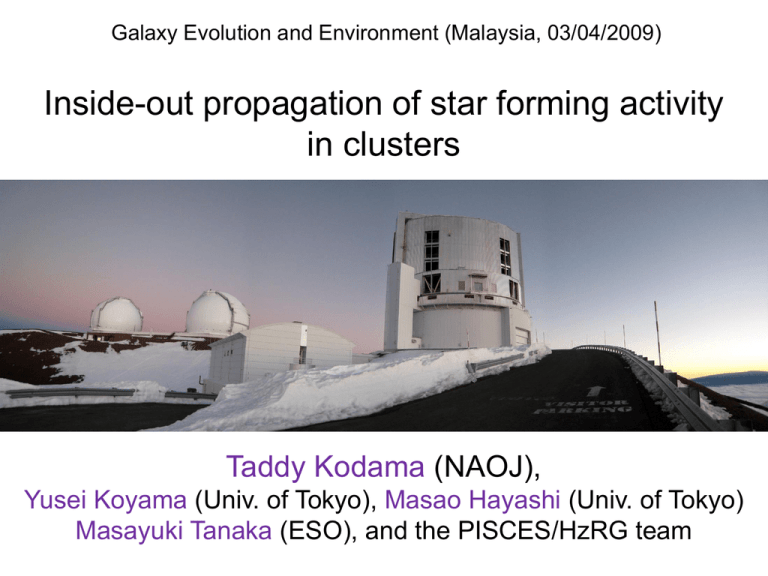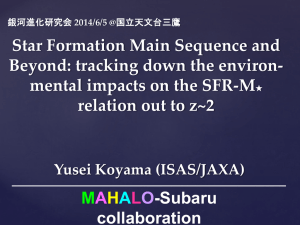malaysia09_proc - Galaxy Evolution and Environment
advertisement

Galaxy Evolution and Environment (Malaysia, 03/04/2009) Build-uppropagation of the red sequence of galaxies Inside-out of star forming activity through cosmic time and across environment in clusters Taddy Kodama (NAOJ), Yusei Koyama (Univ. of Tokyo), Masao Hayashi (Univ. of Tokyo) Masayuki Tanaka (ESO), and the PISCES/HzRG team Outline Large scale structures in and around clusters at all redshifts (0.4<z<3) Starbursts and truncation in groups/outskirts at z<1 (z~0.8) (Koyama+ 08;09 in prep.; see Koyama’s poster) High SF activity in the cluster core at z~1.5 (Hayashi+09, in prep) Disappearance of the red sequence at z>2 Origin of Environmental Dependence N-body simulation of a massive cluster z = 30 z=5 (Yahagi+05) z=3 z=2 MOIRCS (NIR) 4’×7’ Suprime-Cam (Opt) z=1 Nature? (intrinsic) 34’×27’ z=0 Need galaxy to go higher redshifts it earlier formation and as more becomes moreinimportant at high-z. massive haloes dense environments Nurture? (external) Need to go outerinteraction/mergers, infall regions to see galaxy-galaxy directly what’s happening there. gas-stripping M=6×1014 M◎ 20×20Mpc2 (co-moving) Panoramic Imaging and Spectroscopy of Cluster Evolution with Subaru ~10 X-ray detected clusters at 0.4 < z < 1.45 ( ) ( ) ,NB ( ) ( ( ) ) ACS(3.5’) ( z~1.4 ) 1.14 (XMMU2235.3-2557) 22 35 20.6 -25 57 42.0 1.393 XMMJ2215.9-1738 22 15 58.5 -17 38 02.5 1.45 XMM 3.0 4.4 VRi’z’ VRi’z’,NB Kodama et al. (2005) XMM XMM High redshift(z) Radio Galaxies [HzRG] with Subaru, VLT, and Spitzer 7 confirmed proto-clusters at 2 < z < 5.2 associated to radio galaxies Overdense regions in Lyman-α emitters by a factor of 3—5. Name redshift NIR PKS 1138-262 4C 23.56 USS 1558-003 USS 0943-242 MRC 0316-257 TNJ 1338-1942 TNJ 0924-2201 Spitzer 2.16 JHKs 3.6--8.0 2.48 JHKs 3.6--8.0 2.53 JHKs 3.6--8.0 2.92 JHKs 3.6--24.0 3.13 JHKs 3.6--8.0 4.11 JHKs 3.6--8.0 5.19 JHKs 3.6--24.0 Lya spectra others 16 NIR/Opt Ha, VLA, Chandra, SCUBA NIR Ha 29 32 37 6 Opt NIR Suprime-Cam, VLA, MAMBO Suprime-Cam/ACS (LBGs) primarily using MOIRCS/Subaru and Hawk-I/VLT Kodama et al. (2007), De Breuck et al. (Spitzer HzRGs) Panoramic Views of Cluster Assembly Spatial distribution of phot-z members (Δz =-0.05~+0.03) CL 0016+16 (BVRi’z’) RXJ 0152.7-1357 (VRIz’) z=1 z=0.83 (7Gyr ago) z=0.55 (5.4Gyr ago) simulation Kodama, et al. (2005) A Huge Cosmic Web at z=0.5 over 50 Mpc (80’x80’ by 7 S-Cam ptgs.) CL0016 cluster (z=0.55) S-Cam Millenium Simulation (Springel et al. 2005) Traced by red-sequence galaxies in V-I colours (Tanaka, et al., in prep.) Structures in proto-clusters Spatial distribution of NIR-selected member candidates and emitters Kodama, et al. (2007) ● DRG ○Lyα △Hα ● DRG ● PKS 1138-262 (z~2, 10.5Gyr ago) r-JHK ● b-JHK ○Lyα USS 0943-242 simulation z=2 (z~3, 11.5Gyr ago) Sharp colour transition in groups/outskirts high med low 銀河の色は中間的な環境で急激に変化する RXJ1716 cluster (z=0.81) ( 赤 い 銀 河 の 割 合 ) high ~ cluster core med ~ group / filament low ~ field Koyama, TK, et al. (2008) AKARI “Deep” and “Wide” MIR Imaging of a NEP Cluster RXJ1716 (z=0.81) Koyama, TK, et al. (2008), see also a poster by KOYAMA AKARI IR satellite, D=69cm, 1.7<λ<180μm AKARI Spitzer Subaru Deep imaging (67μJy) at 15μm PAH (7.7μm) at z=0.81 Dusty star forming galaxies (LIRG/ULIRG) SFR > 20 Msun/yr (LIR > 1011 Lsun) Spatial Distribution of the 15μm sources A void of 15um sources at the center! ○single /△blended 15μm sources Koyama, TK, et al. (2008) X-ray (Chandra) map (Jeltema et al.) Spatial Distribution of the 15μm sources f(15μm) > 67 μJy ○△ red15μm sources (dusty) high SSFR (starbursts) Optically red 15μm sources are preferentially found in the medium density regions. Koyama, TK, et al. (2008), see also talk by Saintonge/Haines/Gallazzi… 16” = 130kpc Interacting Galaxies in the 15μm sources Subaru (optical) AKARI (NIR) Koyama, TK, et al. (2008) A narrow-band Hα imaging with MOIRCS/Subaru RXJ1716 cluster (z=0.813) J ~ 30min (23.1 mag, AB, 5σ) continuum NB119 ~ 100min (22.7 mag, AB, 5σ) Hα emission NB119 J AKARI FOVs Ha emission from z=0.81 galaxy MOIRCS FOV NB119 resp. func. ○:15mm sources Koyama, TK, et al. (2008), see also a poster by KOYAMA spec-z distribution (Gioia+ 99) Selection of Hα Emitters associated to the RXJ1716 cluster (z=0.81) SFR (Hα) > 1.5 M◎/yr Definition of emitters 3σ error in colours [OIII] Hα [OII] EW~20A 5σ Hα emitters are defined as the NB119 emitters which are either phot-z members (27) or those at the top-left corner in Ri’z’ diagram (10). Spatial Distribution of Hα emitters Hα emitters are avoiding the central region ( Rc < 230kpc ) and preferentially found in the surrounding regions. None! MOIRCS FoV None ! : Ha emitter with > 2 Msun/year distance from the x-ray centre Spatial distributions of Hα emitters and 15μm sources are similar (but direct overlaps are only 8). Hα emitters on the red sequence! Most of them are located in the outer region ( Rc>500kpc ). □ : EW > 50 A □ : EW < 50 A □ Hα emitters What are the red Hα emitters? Koyama, TK, et al. (2009) Strong dust extinction even for Hα? (or dusty AGN?) R z’ J blue Hα emitters □ ☆ red Hα emitters ○ 15μm sources (Pozzetti+2000) A similar method There may that are be aused largetoamount separate of between hidden star passive/dusty formation inEROs IR with IJK that measures the sharpness which of is the not 4000Å/Balmer seen even withbreak Hα??feature. A narrow-band [OII] imaging with Suprime-Cam/Subaru (XCS2215@z=1.457) Hayashi et al. (2009), in prep. XMMXCS J2215.9-1738 [OII] @ z=1.46 z’ NB912 (Stanford+06 ) instruments passbands ↓ B Suprime-Cam NB912 z’ NB912 filter (lc=9139A, Dl=134A) MOIRCS J Ks dates 2008. 07.30-31 2008. 06.30-07.01 pointings 1 4 FoV 32’ x 23’ 6.1’ x 5.8’ 3σ mags seeing 27.59 25.81 1.09” 25.75 23.84-24.57 23.07-23.65 1.09” Selection of [OII] emitters associated to the XCS2215 cluster (z=1.46) 5s 3s NB912 emitters Spectroscopically confirmed members (Hilton et al. 2007) [OII] emitters (44) [OII] @ z=1.46 3s Ha @ z=0.4 [OIII] @ z=0.84 SFR ([OII]) > 2.6 M◎/yr Hayashi et al. (2009), in prep. Spatial Distribution of the [OII] emitters High star formation activity to the very center of the cluster! (AGN contamination?) Hayashi et al. (2009), in prep. Spatial Distribution of the [OII] emitters fraction to field corrected phot-z members High star formation activity to the very center of the cluster! (AGN contamination?) Hayashi et al. (2009), in prep. Star forming activity in the cluster cores □ Hα emitters at z=0.81 (RXJ1716) ● Koyama, TK, et al. (2009) □ [OII] emitters at z=1.46 (XCS2215) phot-z members Hayashi, TK, et al. (2009) Inside-out propagation of star forming activity in cluster cores !? Can we eventually see a reversal of the SFR-Rc / SFR-density relations? Hα @ z=0.8 Hα @ z=0.4 [OII] @ z=1.5 (Koyama+09) (Hayashi+09) (Kodama+04) Radius [Mpc] 1000 Radius [arcmin] PAH @ z=0.8 [OII] @ z=1 0.6 0.4 0.2 100 10 Density [Galaxies/Mpc2] 1 high low 2 Density [Galaxies/Mpc ] (Cooper +08) log <SFR> (Koyama+08) (Poggianti+08) (Poggianti+08) SSFR [OII] fraction [OII] @ z=0.4-0.8 Radius [arcmin] high Density low see also Elbaz et al. (2007) Emergence of the red-sequence at z~2 in proto-clusters? z~2 (PKS1138) ● DRG(J-K>2.3) z~3 (USS0943) ● r-JHK ● b-JHK RG Kodama et al. (2007) The red sequence seems to be emerging between z=3 and 2 ( 2 < Tuniv[Gyr] < 3). Summary Starbursts/truncation of galaxies in groups/ outskirts of clusters at z<1 External effects (“Nurture”) (galaxy-galaxy interaction?) Formation of massive galaxies in cluster cores at z>1.5-2 Intrinsic effects (“Nature”) (galaxy formation bias?) “Inside-out propagation/truncation of star formation in clusters?”





![Evolution of the H $\ beta $+[OIII] and [OII] luminosity functions and](http://s2.studylib.net/store/data/018513661_1-b3a03612937a2f73b4f5dcbe420e49cd-300x300.png)